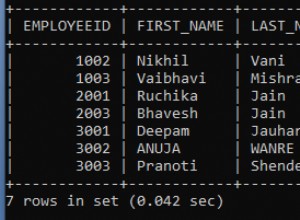Bạn cần xác định các nhóm ngày liên tiếp có oos =1 hoặc 0. Điều này có thể được thực hiện bằng cách sử dụng hàm LAG để tìm khi nào cột oos thay đổi và sau đó tổng hợp lại.
with x (s_date,qty,oos,chg) as (
select s_date,qty,oos,
case when oos = lag(oos,1) over (order by s_date)
then 0
else 1
end
from stk
)
select s_date,qty,oos,
sum(chg) over (order by s_date) grp
from x;
đầu ra:
| S_DATE | QTY | OOS | GRP |
|--------------------------------|-----|-----|-----|
| January, 01 2013 00:00:00+0000 | 0 | 1 | 1 |
| January, 02 2013 00:00:00+0000 | 0 | 1 | 1 |
| January, 03 2013 00:00:00+0000 | 0 | 1 | 1 |
| January, 04 2013 00:00:00+0000 | 5 | 0 | 2 |
| January, 05 2013 00:00:00+0000 | 0 | 1 | 3 |
| January, 06 2013 00:00:00+0000 | 0 | 1 | 3 |
Sau đó, bạn có thể tính tổng trên oos này, được phân chia theo cột grp để có được các ngày oos liên tiếp.
with x (s_date,qty,oos,chg) as (
select s_date,qty,oos,
case when oos = lag(oos,1) over (order by s_date)
then 0
else 1
end
from stk
),
y (s_date,qty,oos,grp) as (
select s_date,qty,oos,
sum(chg) over (order by s_date)
from x
)
select s_date,qty,oos,
sum(oos) over (partition by grp order by s_date) cum_days_oos
from y;
đầu ra:
| S_DATE | QTY | OOS | CUM_DAYS_OOS |
|--------------------------------|-----|-----|--------------|
| January, 01 2013 00:00:00+0000 | 0 | 1 | 1 |
| January, 02 2013 00:00:00+0000 | 0 | 1 | 2 |
| January, 03 2013 00:00:00+0000 | 0 | 1 | 3 |
| January, 04 2013 00:00:00+0000 | 5 | 0 | 0 |
| January, 05 2013 00:00:00+0000 | 0 | 1 | 1 |
| January, 06 2013 00:00:00+0000 | 0 | 1 | 2 |
Demo tại sqlfiddle.




